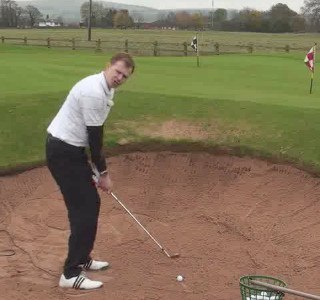
There are few situations around the golf course that scare the average player quite like having to climb down into a bunker to play a shot. The typical golfer would usually prefer to be just about anywhere else other than in the sand – even though bunker shots can be relatively easy when you have the right technique on your side. To help you get over any fears that you may have regarding playing from the sand, we have assembled the following list of helpful tips.
One of the challenges that comes along with playing from the sand is the great number of variables that are present when you get ready to play a sand shot. You will have to assess the condition of the sand, the depth of the bunker, the slope under your feet, the lie of the ball, and much more. If you fail to account for one or more of the variables present when you hit a bunker shot, the results of that shot are not going to live up to your expectations.
Before getting into the tips that we have collected to help you play your best out of the sand, there is one key point that needs to be made – you need to practice your bunker shots! Most golfers rarely, if ever, practice out of the sand, and the results show on the course. You can’t reasonably expect to play well from the bunkers if you don’t practice, so make this key part of the game a part of your regular practice routine.
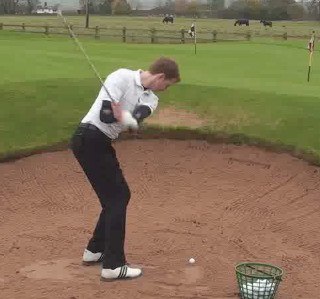
For the first tip on our list, this one probably seems pretty obvious – and even a bit silly. Of course you want to get the ball out of the bunker and back onto the grass. That isn’t exactly breaking news. So why is it the first tip on our list? Because so many people ignore this basic concept each time they find their ball in the sand. Instead of just trying to get the ball out and back in play, countless players try to execute the perfect bunker shot – and they wind up leaving their ball in the sand as a result.
When you get down into a bunker to review your lie and your path to the hole, your first thought should be about getting the ball out and onto the grass. Sure, you would love to place the ball close to the hole for an easy putt, but don’t get ahead of yourself – before anything else, make sure the shot you pick is going to get your ball safely out of the sand. Are you using enough loft to clear the lip in front of you? Is your lie good enough to take the line you have picked out for the shot? Ask yourself these questions and any others that might relate to getting out of the bunker.
Even if you fail to get the ball close to the hole with a given bunker shot, just getting out of the sand and onto the grass will be a relief. You can quickly waste two or three (or more) shots down in a bunker if you try to pull off the perfect shot and it doesn’t work out. Bunkers are considered hazards under the rules of golf for a reason – they are not a good place to be, and you want to get out as fast as you can. Be smart, pick a safe shot, and move on with your round after getting out of the bunker in a single swing.
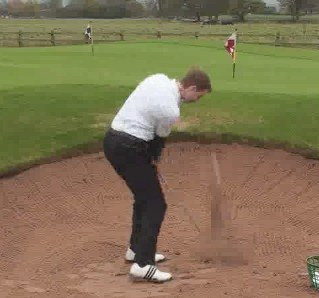
Yes, most of the bunker shots you hit are going to take place within just a few yards of the green. However, that doesn’t mean that you can make a small, soft swing to handle the shot. In order to hit a quality explosion shot from a greenside bunker, you are going to need to make a big, aggressive swing. By making a big swing, you will be able to slide the club under the ball with ease, allowing the ball to float up out on the sand and onto the green.
The reason that you need to make a big swing on this kind of shot is the density of the sand that is sitting under the ball. Unlike a normal shot, where you just contact the back of the ball with the club, an explosion shot requires you to actually miss the ball – you are going to swing under the ball, using the sand to move the ball toward the hole. So, in order to move enough sand with enough speed to pull this off, you have to swing quite hard. It will take a little bit of practice to get comfortable making a big swing from so close to the game, but it shouldn’t take long before you get the idea.
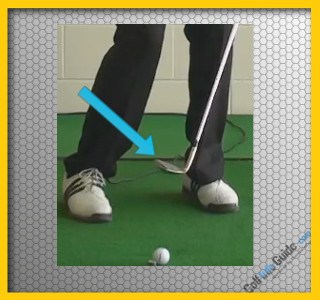
This is the point that amateur golfers miss more than any other with regard to the bunker game. When you are trying to hit an explosion shot from a greenside bunker, you need to lay the face of your wedge dramatically open at address. Not just a little bit open – the face should be pointing almost directly up at the sky as you prepare to swing. Opening up the face in this manner will allow you to get maximum loft on the shot as it comes out of the sand, which is crucial for making sure you get over the lip in front of you.
Also, opening the face at address is going to expose the ‘bounce’ on the bottom of the club to the sand when you swing through the hitting area. The bounce on the sole of your wedge will allow the club to ride through the sand without digging in too deep. If you keep the face square, the club head will likely dig in and you won’t be able to carry the necessary speed all the way through the swing. With an open face, you can avoid the problem of getting stuck in the sand, and you can keep your swing moving all the way through to the finish.
There is only one problem with laying the face open, and it is the problem that causes most golfers to square the face back up before they swing. What is the issue? Simply put, it looks weird to swing the club this way. When the face is laid open, it looks like all sorts of bad things are going to happen – like you are going to hit the ball directly up into the air, or you are going to miss it completely. This is where practice becomes so important. By hitting plenty of practice bunker shots with the face of your wedge laid flat, you will get comfortable with the way this looks, and it won’t bother you out on the course.
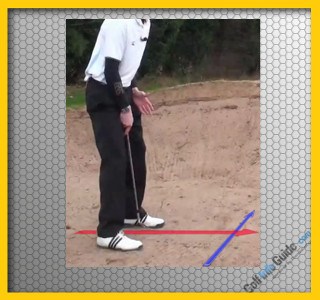
When playing a greenside bunker shot, you should always ‘wiggle’ your feet down into the sand before you make your swing. This is an important step because it establishes a firm base for your feet which will help you to stay in place while hitting the shot. Sand is often slippery, especially when it is dry, so failing to work your feet down into the sand will leave you at risk of slipping at the worst possible time. In addition to setting your feet in place, you should also use a wide stance and plenty of knee flex to create a solid platform on which to swing.
As you work your way down into the sand, you need to remember to choke down an inch or two on the handle of your wedge to compensate. Since your feet are going to be a bit lower relative to the ball, you need to choke down to avoid hitting the shot fat. Many amateur golfers fail to remember this step, and they take too much sand as a result. So, as part of your preparation for the average greenside bunker shot, remember to both work your feet down into the sand and choke down on the handle of the club.

One of the easiest things to do from a greenside bunker is to hit your target line. You might not get the distance of your sand shots right each and every time, but you should be able to get the ball on line with relative ease. Since you don’t have to worry about the ball hooking or slicing in the air (on a greenside bunker shot – a fairway bunker shot is a different story), you can be confident that you are going to put the shot on line successfully.
So, since you should have a good measure of control over the direction of your sand shots, you want to think strategically before you swing away. Where would you like the ball to end up when it comes to rest? Obviously, you would love to make the shot, but that isn’t going to happen most of the time. Typically, you are going to be hitting your next shot with a putter, so where do you want to putt from? Usually, the answer to that question is simple – the low side of the hole.
Putting uphill is almost always easier than putting downhill, so plan your greenside bunker shots to leave yourself with an uphill putt toward the cup. If you hit a good bunker shot, this uphill putt should only be a few feet in length. Even if you hit a poor shot, you will be much better off putting uphill from long range than you would be if you had a long downhill path to the hole. This is a pretty basic strategic point in the golf world, but it is one that can save you strokes as time goes by. Play to the low side of the hole when facing just about any greenside bunker shot and enjoy the easier putts you will face as a result.

6 – Take It Easy in a Fairway Bunker
So far, all of our tips have related to the shots you are going to hit from a greenside bunker. However, you need to also be prepared to make good swings from fairway bunkers when you have a tee shot drift offline. When you do face a long bunker shot from back in a fairway bunker, one of the best things you can do is to swing with a soft, easy rhythm and plenty of control. You don’t want to swing your hardest in a fairway bunker, as you are likely to lose balance and miss-hit the shot. Fairway bunker success is all about making clean contact, so swinging extra-hard is a recipe for disaster.
As you prepare to hit a fairway bunker shot, make sure you have plenty of club to carry the distance at hand – as long as that club will still allow you to clear the lip in front of you. When you know you have plenty of club, you will be more willing to make a smooth swing that is focused on clean contact rather than raw power. Fairway bunker shots will always be difficult for the average golfer, but avoiding the temptation to swing hard will make these shots quite a bit easier.

7 – Change Your Plan in the Rain
The basic plan for a greenside bunker shot – blasting the ball out with a big swing that cuts under the bottom of the ball – is going to be good in most circumstances. However, it isn’t necessarily going to work when rain is falling (or has recently fallen). If the sand you find in a greenside bunker is firm due to rain, you will need to adjust your approach in order to get the ball out safely.
If you find yourself playing from a bunker with hard-packed sand, the first thing you need to do is assess the height of the lip in front of you. This factor is going to have a lot to do with what kind of shot you can play. If the lip is high, you are going to have little choice but to go for the same kind of bunker shot as you would play from softer sand. However, when the lip is low, you can opt for a chipping-style shot that has you pick the ball off the top of the sand with one of your wedges.
To hit this kind of shot, you will want to use your chipping motion with the ball set back in your stance. You need to think about sweeping the ball off the top of the sand when you attempt this shot – if you play the shot with a swing that is too steep, you are going to hit down into the sand and the club will stop abruptly. Make it a goal to disturb as little sand as possible, meaning you are just going to pick the ball off the top while barely leaving a mark on the way through. This shot isn’t as consistent as an explosion shot for most people, but it might be your best bet when the sand is wet and firm.

One of the best pieces of advice you can receive with regard to playing shots out of the bunkers is simply to avoid hitting your ball in those bunkers in the first place. By definition, bunkers are not nice places to be when you are playing a round of golf. You will never be as consistent from the sand as you will be from the grass, and there is always an element of luck involved with bunker play (especially when it comes to drawing a good lie).
As you prepare to hit any full shot during a round of golf, always take note of where the bunkers are located on the hole in front of you. While you don’t have to play completely away from the bunkers, you also shouldn’t put yourself at too much risk by aiming right at their edges. Give yourself a little margin for error to keep the ball out of the sand as much as possible, and always make sure you have enough club in your hands to carry any bunker you plan on going over.
There is one other point that needs to be made regarding this tip, and it is the fact that not all bunkers are created equal. Some greenside bunkers are actually not too bad, especially when they give you a good angle toward the hole and plenty of green to work with. However, other bunkers are particularly nasty, especially when they have high side walls and are placed awkwardly compared to the green. So, as you plan your shots, be sure to think about which bunkers aren’t too bad, and which are going to be a big problem. Grading bunkers this way will tell you which to stay away from completely, and which you can risk coming close to in the hopes of hitting a great shot.
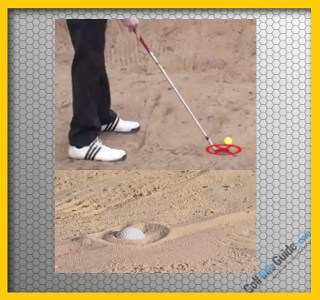
One of the first things that you should do when stepping down into a bunker is to read the lie of your ball carefully. The way the ball is sitting in the sand has everything to do with how you are going to be able to play the shot in front of you. If the ball is up on top of the sand, you will be able to do just about whatever you like with the shot. However, when the ball is sitting down deep – to where you can only see half of the ball or so above the level of the sand – you are going to be lucky just to get out.
When you do draw a bad lie, which is more common when the sand is soft, you should immediately think about finding the path of least resistance out of the bunker. Even if you have to play in completely the wrong direction, the only thing you should care about is getting back onto the grass. Only when you draw a good lie should your brain think about being aggressive and hitting a great shot up close to the hole.
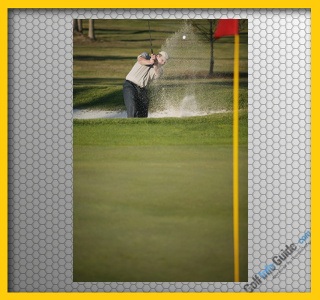
This is a tip that can be applied to any shot on the golf course, but it is especially important in the sand since so many players get nervous as they walk into a bunker. When you have to play a bunker shot, you can’t let your fears or doubts enter into the equation – you need to be confident, aggressive, and optimistic about your chances of success.
Of course, you can’t fake confidence on the golf course, so you have to come by it honestly – and the best way to find confidence is through practice. When you regularly practice your bunker game, you will start to realize that you are capable of playing great shots from the sand. Even if you only practice in a bunker for a few minutes after you have finished hitting range balls, those few minutes are going to be incredibly valuable to your game. The confidence that you gain during your practice sessions will translate directly onto the course, and you will feel much better about your chances of hitting a great shot when you find your ball in the sand. Are you ever going to look forward to being in a bunker? No, probably not – but thanks to your practice and newfound confidence, you will be able to rise to the occasion when necessary.
All of the tips listed above can help you to perform at a higher level when your ball is in the sand. Review the list carefully and decide which of the tips are going to be of the most benefit to you. Use those tips first to make some progress, and then return to the list to find other tips that can take you even farther. Good luck and play well!





